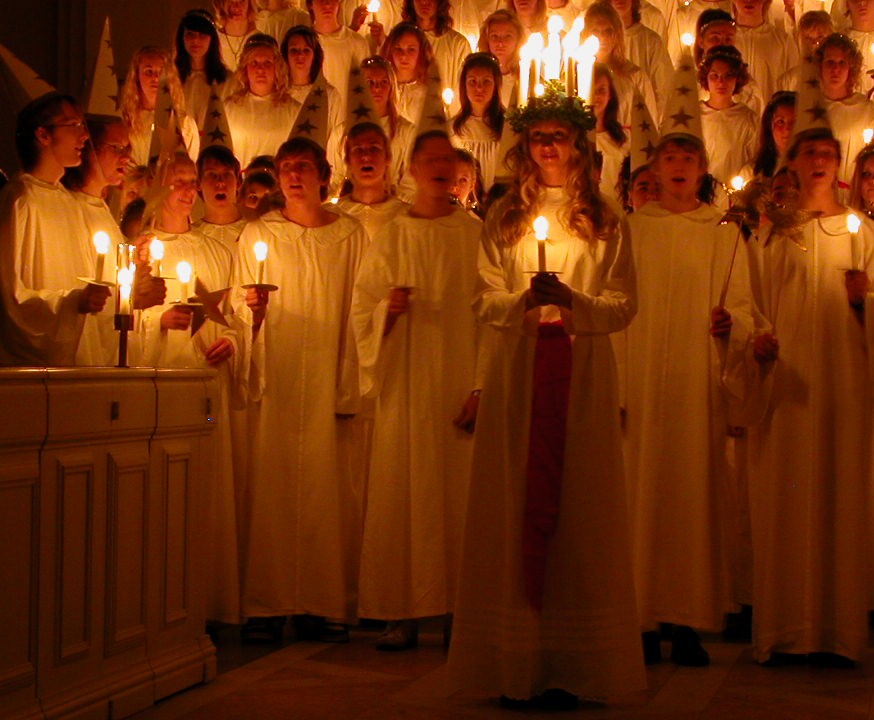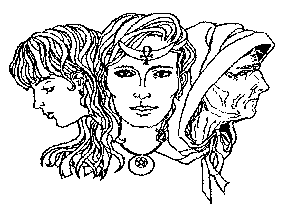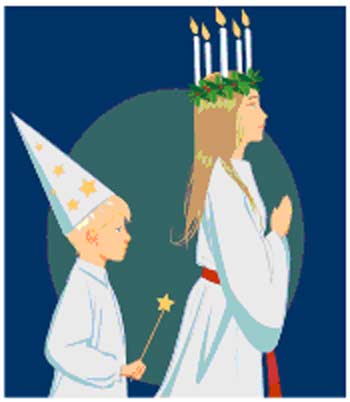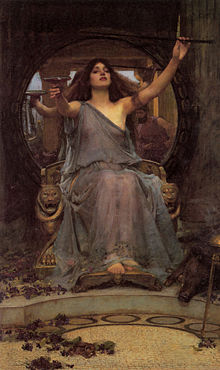14 November 2010 (Rishon/Pesach)
Day #243, 5934 AM
Santa Lucia/St.Lucy's Day
A Pagan Festival in Catholic Garb

Santa Lucia (from the Latin lux meaning 'light') is a Christianised pagan fertility festival of lights, created by the Roman Catholic Church in the 16th century, that takes place at the winter solstice and was observed anciently in honour of the young maiden goddess, thus identifying her as either one of the triad of demonesses known as HECATE or the daughter of Hecate and Helios. The festival plays a prominent rôle leading up to the celebration of Christmas in the Lutheran/secular culture of Sweden and the Swedish-speaking population of Finland. It is also observed in Lutheran Norway, Denmark, Iceland, Latvia and Estonia and Catholic Malta, Italy, Bavaria, Croatia and Slovakia, though to a lesser degree. In those parts of the USA where there are those of Scandinavian ancestry, it is known as St.Lucy's day. The festival was observed in pagan Europe long before the arrival of Christianity.
'Lussi' (as Lucia or Lucy was originally known), an evil female being like a demon or witch known as Lucia die Dunkle, rode through the air with her followers, the Luciferda. Between Lussinatta or Lucy Night and Yule, trolls, evil spirits and the spirits of the dead were thought to be particticarly active so people stayed indoors. It was believed that Lucci could come down through chimneys (like Santa Claus) and steal children away to punish households, so the spirits had to be placated with offerings to prevent this happening. Because of this fear, Lussevaka was observed - staying awake all night to protect oneself from supposed attack. Today this is carried over in partying all night until daybreak.
 The Hecate Triad, with Lucci on the left
The Hecate Triad, with Lucci on the left
On top of this pagan superstition, the Catholic Church superimposed one of several stories, one of which is of an Italian saint from Sicilly who was martyred for her faith. The legend has it that Lucy was seeking help for her mother, Eutychia's, long-term illness at the shrine of St.Agnes (Agatha) when an angel appeared to her in a dream beside the shrine. As a result of this, Lucy became a devout Catholic, refused to get married to the pagan man she was engaged to, and was denounced to the Roman authorities by her jilted fiancée. She was threatened with rape in a brothel if she did not marry her fiancée but she refused, and 1,000 men and 50 oxen could not move her, so she they tried to burn her alive, and failed in that. She was finally dispatched with a sword in her throat on 13 December, 304. Some traditions say her eyes were gouged out too. The other story is that Lucy ministered to Christians hiding in the catacombs of Rome during the persecution of Diocletian. To enable her to have both hands free so that she could carry as many supplies as possible, it is claimed that she attached a ring of candles to her head.
Catholics with eye trouble or blindness still invoke their patron saint Lucia today for healing. In nominally Lutheran Sweden, Santa Lucia marks the beginning of the Christmas season. Traditionally (though this is not observed everywhere), the oldest (or youngest) daughter in each household traditionally carries a tray of coffee and traditional pastries called lussekatter (Lucy cats) to her parents before they get up in the morning. She wears a white gown, scarlet sash, and a crown of greens and 4, 7 or 9 lighted candles. Her brothers, wearing white shirts and tall, cone-shaped hats decorated with stars, and her sisters, all in white and carrying lighted candles, follow her. In many towns, a St.Lucy is chosen to carry coffee and buns to each house, a tradition stared in 1927 in Stockholm. Today there is even a National Lucia. She and her followers, each bearing a lighted candle, sing carols as they traverse the dark streets white St.Stephen, represented by a man on horseback, leads the way. The procession is done in memory of St.Lucy's traversing darkened woods to bring bread and other food to the poor.
In Switzerland St.Lucy strolls around the village with Father Christmas, giving gifts to the girls while he gives gifts to the boys. In Venice, the festival is celebrated by enjoying fried cheese and Italians generally eat small cakes or biscotti shaped like eyes, light huge bonfires, and conduct evening candlelight processions to honour St.Lucy. Sicillians pay tribute to a miracle supposedly performed by St.Lucy during a famine in 1582. At that time, she is supposed to have been responsible for bringing a flotilla of grain-bearing ships to starving Sicily, whose citizens cooked and ate the wheat without taking the time to grind it into flour. Thus on St.Lucy's day Sicillians don't eat anything made with wheat flour but eat cooked wheat called cuccia.
Santa Lucia is one of seven women commemorated in the Catholic Mass and Catholics pray to her, addressing her in prayers reminiscent of those given to the Virgin Mary: "Saint Lucy, virgin and martyr, hear my prayers and obtain my petitions".
The modern Catholic and Luthetran tradition is clearly a blending of paganism, myth and possibly an historical character from early Christian times famous for charitable deeds. Religious syncretism - the blending together of biblical and pagan tradition - is strictly forbidden in the Bible and was responsible for the fall and condemnation of Israel anciently. Sadly, it is still going on with each tradition constantly mutating. We are forbidden to invent our own religious festivals or to imitate the heathen. Rather, Yahweh has given us His appointments or moedim which are complete and totally sufficient for the true believer. We are to observe these, and no other, until Yah'shua (Jesus) returns. Upon careful examination it will be discovered - as we have discovered time and time again - that every non-moed - is in reality a festival to a demon and therefore Satan-honouring. You might not think that such a charitable figure as Lucy has a wicked spirit behind it, but then who would have thought the Catholic Virgin Mary was a demonic counterfeit too?
Things in the world are not as they appear to be and the only safety is to strictly obey Yahweh's tavnith or divine pattern in all emet or truth. Though a minor festival elsewhere, Santa Lucia is mostly of interest to Swedes where it is fully integrated into the culture, playing a rôle equal to that of the equally pagan Christmas. Swedes are uncertain of its origin in their country but generally agree the festival did not become a part of the culture until the 1700s amongst the upper classes on Christmas Eve. Some believe it was an imported tradition from Germany in which Protestant girls were dressed as angelic Christ-children handing out Christmas presents, a variant of the Kindchen Jesus or Christkind, that came to be known as Kinken Jes.
 Lucia leading a Star Boy with wand
Lucia leading a Star Boy with wand
Another theory, which is probably the truer of the two, is that Santa Lucia observation evolved from old Swedish traditions of 'star boys' (stjärngossar) and white dressed angels singing Christmas carols at different events during Advent and Christmas. In modern Sweden there are also tomtenissar boys carrying lanterns and some are dressed as gingerbread men. High school students party throughout the night and at universities formal dinner parties are held before they go home to their families at Christmas. The tradition of a white-dressed girl with candles in her hair can be more definitively traced to Lake Vänern of the late 1700's which then spread slowly to other parts of the country in the 1800's. Whatever the truth, clearly many traditional streams have converged and merged that hearken back originally to Sweden's dark pagan Viking past and to Hecatic mother-goddess worship. One thing is clear: it is nothing a true, Bible-believing Christian/Messianic should have anything to do with however colourful and bright the festival may be with its hauntingly beautiful siren-like Santa Lucia hymn and children dressed up to look like angels.
 Finally, observe the magic wand carried by the boys, wands being occult symbols of power (sceptres) of the goddess Circe, the goddess of magic (from which we get our English word 'church' viâ the Scottish kirk, the Swedish kyrka, the Norwegian kirke and the German kirche), the daughter of Helios, the sun, and of Hecate. The boy follows the goddess Hecate (Santa Lucia) in the matriarchal occult order.
Finally, observe the magic wand carried by the boys, wands being occult symbols of power (sceptres) of the goddess Circe, the goddess of magic (from which we get our English word 'church' viâ the Scottish kirk, the Swedish kyrka, the Norwegian kirke and the German kirche), the daughter of Helios, the sun, and of Hecate. The boy follows the goddess Hecate (Santa Lucia) in the matriarchal occult order.
Right >
The pagan goddess Circe
daughter of Hecate,
holding up her wand/sceptre
(Waterhouse painting)
Thus the whole symbolism of Lucia is perverse, reversing Yahweh's order, and in so many ways reflecting the corrupt socio-political-religious system in contemporary Sweden.
 Share
Share
|


